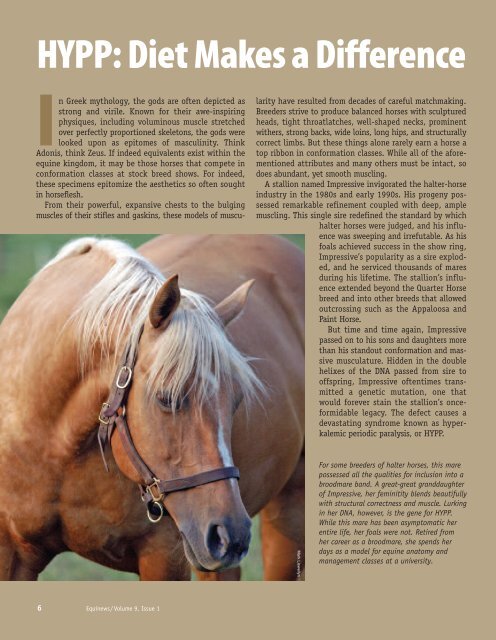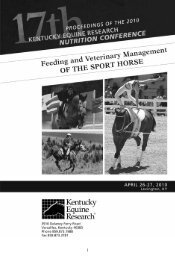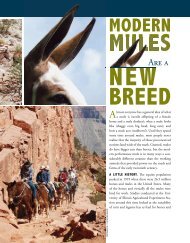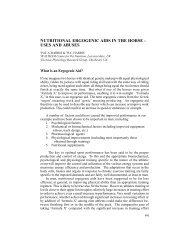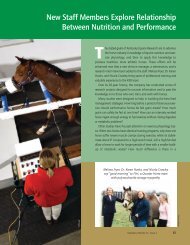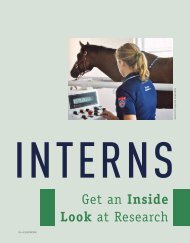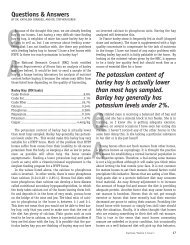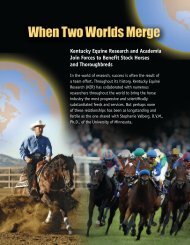HYPP: Diet Makes a Difference - Morgan Equine Veterinary ...
HYPP: Diet Makes a Difference - Morgan Equine Veterinary ...
HYPP: Diet Makes a Difference - Morgan Equine Veterinary ...
- No tags were found...
You also want an ePaper? Increase the reach of your titles
YUMPU automatically turns print PDFs into web optimized ePapers that Google loves.
<strong>HYPP</strong>: <strong>Diet</strong> <strong>Makes</strong> a <strong>Difference</strong>In Greek mythology, the gods are often depicted asstrong and virile. Known for their awe-inspiringphysiques, including voluminous muscle stretchedover perfectly proportioned skeletons, the gods werelooked upon as epitomes of masculinity. ThinkAdonis, think Zeus. If indeed equivalents exist within theequine kingdom, it may be those horses that compete inconformation classes at stock breed shows. For indeed,these specimens epitomize the aesthetics so often soughtin horseflesh.From their powerful, expansive chests to the bulgingmuscles of their stifles and gaskins, these models of muscularityhave resulted from decades of careful matchmaking.Breeders strive to produce balanced horses with sculpturedheads, tight throatlatches, well-shaped necks, prominentwithers, strong backs, wide loins, long hips, and structurallycorrect limbs. But these things alone rarely earn a horse atop ribbon in conformation classes. While all of the aforementionedattributes and many others must be intact, sodoes abundant, yet smooth muscling.A stallion named Impressive invigorated the halter-horseindustry in the 1980s and early 1990s. His progeny possessedremarkable refinement coupled with deep, amplemuscling. This single sire redefined the standard by whichhalter horses were judged, and his influencewas sweeping and irrefutable. As hisfoals achieved success in the show ring,Impressive’s popularity as a sire exploded,and he serviced thousands of maresduring his lifetime. The stallion’s influenceextended beyond the Quarter Horsebreed and into other breeds that allowedoutcrossing such as the Appaloosa andPaint Horse.But time and time again, Impressivepassed on to his sons and daughters morethan his standout conformation and massivemusculature. Hidden in the doublehelixes of the DNA passed from sire tooffspring, Impressive oftentimes transmitteda genetic mutation, one thatwould forever stain the stallion’s onceformidablelegacy. The defect causes adevastating syndrome known as hyperkalemicperiodic paralysis, or <strong>HYPP</strong>.Mark LlewellynFor some breeders of halter horses, this marepossessed all the qualities for inclusion into abroodmare band. A great-great granddaughterof Impressive, her feminitity blends beautifullywith structural correctness and muscle. Lurkingin her DNA, however, is the gene for <strong>HYPP</strong>.While this mare has been asymptomatic herentire life, her foals were not. Retired fromher career as a broodmare, she spends herdays as a model for equine anatomy andmanagement classes at a university.6 <strong>Equine</strong>ws/ Volume 9, Issue 1
Understanding <strong>HYPP</strong>Here’s a short list of terms that may be helpfulas you learn more about <strong>HYPP</strong> by reading thisarticle and others.• asymptomatic – presenting no symptoms orsigns of disease• genetic mutation – a relatively permanentchange in hereditary material involving eithera physical change in chromosome relations ora biochemical change in the codons that makeup genes• heterozygous – having the two alleles atcorresponding loci on homologous chromosomesdifferent for one or more loci (in thecase of <strong>HYPP</strong>, N/H)• homozygous – having the two genes atcorresponding loci on homologous chromosomesidentical for one or more loci (in thecase of <strong>HYPP</strong>, H/H)• hyperkalemic – having elevated potassium levels• paralysis – inability to move• periodic- occuring or recurring atregular intervals• potassium – an electrolyte vital for normalfunction of nerves and muscles, amongother functions• sodium – the most plentiful electrolyte in thebody, essential for normal body processes• symptomatic – showing a symptom or asign of a diseaseAfter testing, horses are given one of three designations:normal (N/N), heterozygous positive (N/H), orhomozygous positive (H/H). Because <strong>HYPP</strong> is a dominanttrait, it is readily passed from generation to generation.Only four genetic scenarios exist: (1) when a N/N horse isbred to a N/H horse, 50% of resulting foals will be H/Nand 50% will be N/N; (2) when a N/N horse is bred to aH/H horse, 100% of resulting foals will be N/H; (3) whena N/H horse is bred to a N/H horse, 50% of resulting foalswill be N/H, 25% will be H/H, and 25% will be N/N; and(4) when a N/H horse is bred to a H/H horse, 50% ofresulting foals will either be H/H or N/H.Most horses considered “positive” are N/H, as thoseidentified as H/H are the most fragile, requiring meticulouscare and management for long-term survival.Preventing Attacks in <strong>HYPP</strong>-Positive Horses<strong>Diet</strong>ary management is key to preventing attacks.Potassium abounds in the normal diets of horses.Therefore, limiting potassium intake is the most crucialelement. Total potassium in the diet should not exceed1%. Requirements differ depending on the lifestyle of thehorse. Sedentary horses may require less potassium, andintense exercise may increase that requirement twofold.An equine nutritionist should be consulted if questionsarise while formulating a diet for a horse with <strong>HYPP</strong>.Forages. Whether it’s pasture, hay, or hay cubes, forageconstitutes the basis for all equine diets. For horses afflictedwith <strong>HYPP</strong>, forage choices narrow considerably.According to Nutrient Requirements of Horses, produced bythe National Research Council, grass forages generallycontain 1-2% potassium and would be classified as middlepotassiumfeedstuffs. When paired with a low-potassiumcereal grain, a suitable diet can be formulated. The additionof an all-purpose vitamin and mineral supplementmay be necessary. Even though this supplement will likelycontain potassium, when fed with other low-potassiumfeeds, the total diet will not contain excessive potassium.Legumes, particularly alfalfa, tend to be higher in potassiumand should be used sparingly or not at all in the dietsof <strong>HYPP</strong>-positive horses.If the horse is an easy keeper (maintains his weightwell on little feed), he may derive sufficient calories frompasture alone. Be astute as to the plants within the pasture,however. Fields should not contain significantlegumes such as varieties of clover. Low-potassium plantsshould comprise the majority of plant life in paddocks andpastures intended for <strong>HYPP</strong>-positive horses.A reminder: Hay and pasture can be tested for potassiumcontent. Contact an equine nutritionist or a local orstate extension specialist to learn more about forage test-8 <strong>Equine</strong>ws/ Volume 9, Issue 1
Mark Llewellynappropriate for horses that are not sensitive tostarch. If calories must be added and starch-ladenfeeds are not an option, calorie-dense vegetableoils are safe.Salt and water. Salt and water are critical foraffected horses. A lack of either reduces urination,which is how the horse rids superfluous potassiumfrom the body. A white salt block is best.Supplements. Read carefully the ingredient listsof any supplements intended for an <strong>HYPP</strong> horse.Most commercial electrolytes are unsuitable forthese horses as they contain high levels of potassium.If the label does not reveal ingredients or aguaranteed analysis, contact the manufacturer toget the information.Because of Impressive’s incredible prepotency, he was often crossed with Appaloosamares. Before purchasing a Quarter Horse, Appaloosa or Paint with Impressive in itspedigree, be sure to ask about the horse’s <strong>HYPP</strong> status.ing. Your local feed store may also be able to help youwith this service.Concentrates. Most commercially prepared sweet andpelleted feeds are a no-no for <strong>HYPP</strong>-positive horsesbecause they contain molasses. According to NutrientRequirements of Horses, molasses often possesses as muchas 6% potassium. Soybean meal, far and away the primarysource of protein in sweet and pelleted feeds, is also richin potassium.If textured or pelleted feeds are stricken from the menu,what’s left? Plain oats are the most popular grain fed tohorses and represent a low-potassium option. Oats areMedicationIn addition to strict control of diet, the administrationof acetazolamide has been recommended for<strong>HYPP</strong>-positive horse. Acetazolamide is a diuretic often recommendedby veterinarians, especially for young<strong>HYPP</strong>-positive horses being fed high-protein (and oftenhigh-potassium) diets to promote growth. The medicationstabilizes blood glucose and potassium by stimulatinginsulin excretion.It’s not unusual for horses to be maintained on the medicationfor long periods of time. Many halter horses continueto be fed pure alfalfa hay while simultaneously receiving thismedication daily. Breed registries differ in their restrictionson the use of acetazolamide during competitions.ExerciseAQHA’s Position on <strong>HYPP</strong>The American Quarter Horse Association (AQHA)classifies <strong>HYPP</strong> as a genetic defect. Beginning in1998, the association included this statement onthe registration certificates of horses that tracedto Impressive: “This horse has an ancestor knownto carry <strong>HYPP</strong>, designated under AQHA rules as agenetic defect. AQHA recommends testing to confirmpresence or absence of this gene.” If theowner chooses to test the horse and the testreveals a negative finding, the above statement isreplaced by “<strong>HYPP</strong> N/N” on the registration certificate.Mandatory testing for <strong>HYPP</strong> is requiredwith parentage verification.In nutrition and exercise physiology circles, it’s wellknown that exercise increases potassium levels in theblood. Logic would dictate, therefore, that exercise wouldincrease the likelihood of an <strong>HYPP</strong> attack. The opposite hasproven true. A regular exercise schedule is advised. Whenthe horse is not exercised under saddle or in harness, heshould have access to turnout that provides low-potassiumforage, salt, water, and adequate shelter. Stall confinementis often contraindicated for horses with <strong>HYPP</strong>.The Future of <strong>HYPP</strong>-Positive HorsesResponsible breeding is the key to reducing the incidenceof <strong>HYPP</strong> in the stock-horse population. Some horsemen arereluctant to eradicate <strong>HYPP</strong>-positive horses from theirbreeding programs because they often possess the veryqualities that garner not only championship ribbons butglory. But too often that glory comes at a steep price.<strong>Equine</strong>ws/Volume 9, Issue 1 9
Reprint Courtesy ofKentucky <strong>Equine</strong> Research, Inc.3910 Delaney Ferry RoadVersailles, KY 40383Phone: 859-873-1988Fax: 859-873-3781Order Department: 888-873-1988www.ker.cominfo@ker.com


